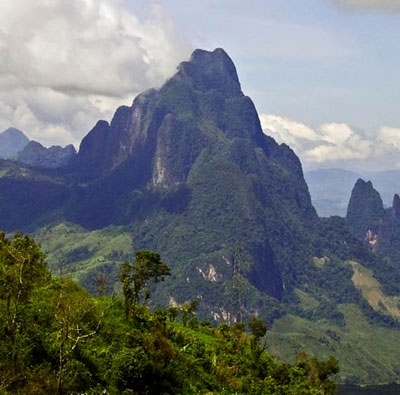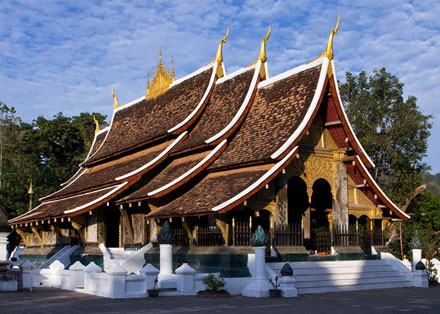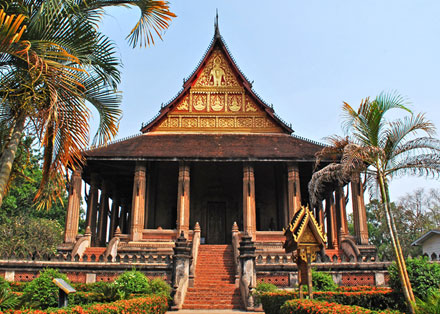Laos
Country statistics

Land area: 89,112 sq miles (230,800 sq km)
Total area: 91,428 sq miles (236,800 sq km)
Population (2010 est.): 6,993,767 (growth rate: 2.3%); birth rate: 33.4/1000; infant mortality rate: 76.0/1000; life expectancy: 56.9; density per sq km: 28
Capital City: Vientiane
Monetary unit: New Kip
Languages: Lao (official), French, English, various ethnic languages
Ethnicity/race: Lao Loum (lowland) 68%, Lao Theung (upland) 22%, Lao Soung (highland) including the Hmong ("Meo") and the Yao (Mien) 9%, ethnic Vietnamese/Chinese 1%
Religions: Buddhist 60%, animist and other 40% (including Christian 2%)
Country introduction

Laos is a landlocked nation in South-east Asia, surrounded by Myanmar, Cambodia, China, Thailand, and Vietnam.
Over half of the country's landscape is densely forested, and 70% of it is mountainous, which has given a profusion of rare flora and over 1,200 species of wildlife that have found a home beneath its tropical canopy.
The highest point in the country is Phou Bia ("Phou", Lao word for mountain), reaching 2,820 m (9,252 ft), which is located in Xiang Khuang province in the north of Laos. However, nearly equally as impressive are the mountains at the southern end of the Annamite range which reach heights of 2,600 m (8,530 ft). The Khammouanne and Bolaven plateaus dominate the central region of the Annamites.
Almost all of the rivers and streams in Laos eventually end up feeding into the Mekong through one of its 15 tributaries, making a total of 2,400 km (1,491 miles) of waterways and feeding the Mekong with more than half of its overall water flow. Laos regularly suffers from water shortages in the low-lying Mekong Delta plains. This can adversely effect the rice crops that account for almost 80% of the country's agricultural land.
The culture

Laos has its own distinct culture. Through Theravada Buddhism it has influences from India and has also influences from China. These influences are reflected throughout Laos in its language as well as in art, literature and the performing arts.
Laos has officially 49 ethnic groups and each of them preserves their own dialect, customs, culture and tradition. The Lao way of life is very much influenced by Buddhism, as can be seen in the way that Lao people live and behave. They are taught to be patient and to accept people. In the past, when law enforcement was not in place, Buddhism was the only thing that bound people together, taught people to be good, and discouraged detrimental behavior. Most villages have at least one temple. These temples are not only places for monks to live and pray, they are also the main center for social and recreational activities such as village meetings, religious ceremonies and festivals.
An important festival in Laos is Boun Pha Vet celebrated once a year. This is a two day Buddhist festival that involves the entire community. Traditionally the Boun Pha Vet is held in January or February depending on the moon cycle. During the ceremony the monks give a sermon of all chapters of the Maha Wetsandon Chadok, otherwise called the Great Birth Sermon.
Laotian music is dominated by its national instrument, the khaen (a type of bamboo pipe). Bands typically include a singer/rapper (mor lam) and a khaen player (mor khaen) alongside fiddlers and other musicians. Lam saravane is the most popular genre of Laotian music, but ethnic Lao in Thailand have developed an internationally-best selling form called mo lam sing. One significant archive of ancient Laotian culture is the Plain of Jars in Xieng Khouang province.
Lao food is distinct from other Asia cuisines, although it is somewhat similar to the food found in the northeastern part of Thailand in the area known as Isan. Most Lao dishes contain vegetables and herbs, rice or noodles and fish, chicken, pork or beef. The freshness of the ingredients is very important to Lao people who like to prepare everything from scratch, rather than use pre-prepared ingredients, as they believe this makes their food more delicious. Herbs such as galangal and lemongrass are favourites and padaek (Lao fish sauce) is found on every table. One of the staples of Laos food is sticky rice. As the name reveals this rice naturally sticks together so it is easy to roll into small balls, dip into food and eat with fingers. A traditional everyday Lao meal is simple and normally consists of sticky rice, some natural vegetables and at least one kind of spicy sauce to dip the sticky rice into, with perhaps some fish or meat. Another daily favourite is noodle soup (called feu also spelt pho) which is a hearty soup incorporating meat, noodles and vegetables.
Attractions & landmarks

The capital of Laos is the city of Vientiane, situated on the banks of the River Mekong. The city is home to plenty of temples, shrines, monuments and markets. The biggest tourist attraction is probably the Wat Pha Kaew or Temple of the Emerald Buddha. This 16th century former royal temple is now a museum and houses a collection of Buddha statues from throughout Asia. The other must-see temple is the Wat Sisaket which is the oldest temple in Vientiane. It also houses a museum of its own with a very modest entry fee off 1000 Kip, this is under 10p in British money. There is also a magnificent triumphal arch called the Anousavari Monument which was built in 1962 to commemorate the lives of people who died defending Laos. Also of interest is the Lao National Museum, the cultural hall and the forested enclave containing the Wat Sokpaluang temple.
The city of Luand Prabang is often quoted as the jewel of Laos. This tiny city houses just 16,000 inhabitants and has been virtually unaffected by the gradual creep of Western culture across Asia. The main tourist attractions are its literally dozens of historic temples. The Wat Xieng Thong and Wat Wisunlat temples are in particular worth visiting. Within half an hours drive are the Pak Ou caves which contain hundreds of Buddha images and the impressive Kuang Si waterfalls south of the city.
Visitors looking for something different will no doubt be fascinated by the Laos "Plain of Jars". This area is situated in the Xieng Khuang province and is littered with enormous stone jars in five major groupings. These jars are of unknown origin but comparison with local rock indicates that they did not originate in the area. The most accessible site is Thong Hai Hin which is set up to deal with tourists and is also the site of the largest 6 and a half tonne jar.